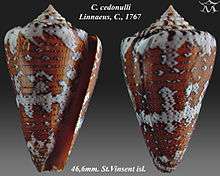Conus cedonulli
| Conus cedonulli | |
|---|---|
 | |
| Apertural and abapertural views of shell of Conus cedonulli Linnaeus, C., 1767 | |
| Scientific classification | |
| Kingdom: | Animalia |
| Phylum: | Mollusca |
| Class: | Gastropoda |
| Clade: | Caenogastropoda |
| Clade: | Hypsogastropoda |
| Clade: | Neogastropoda |
| Superfamily: | Conoidea |
| Family: | Conidae |
| Genus: | Conus |
| Species: | C. cedonulli |
| Binomial name | |
| Conus cedonulli Linnaeus, 1758 | |
| Synonyms[2] | |
| |
Conus cedonulli is a species of sea snail, a marine gastropod mollusk in the family Conidae, the cone snails and their allies.[2]
Like all species within the genus Conus, these snails are predatory and venomous. They are capable of "stinging" humans, therefore live ones should be handled carefully or not at all.
Being a very varied species-complex, there has been much confusion in the course of years about which species and subspecies to assign to the Conus cedonulli-complex, hence the number of synonyms named.
In 1985 D.L.N. Vink proposed assigning the following species to the Conus cedonulli-complex along with Conus cedonulli :[3]
- Conus aurantius Hwass in Bruguière, 1792
- Conus insularis Gmelin, 1791 : considered by Vink to be a synonym of Conus aurantius Hwass in Bruguière, 1792
- Conus mappa sensu Lightfoot, 1786
- Conus sanctaemarthae spec. nov. : now synonym of Conus mappa sensu Lightfoot, 1786
The following subspecies of Conus cedonulli were recognized by the World Register of Marine Species:
- Conus cedonulli dominicanus Hwass in Bruguière, 1792:[4] synonym of Conus dominicanus Hwass in Bruguière, 1792
- Conus cedonulli insularis Gmelin, 1791:[5] synonym of Conus cedonulli Linnaeus, 1767
Description
The color of the species in this complex is white to purplish grey
although specimens from St. Vincent are very often dark-mahogany-brown, with some rare examples being 'black' or near-black.[6]
The shell is crossed by streaks that are alternately light and dark. Between these streaks yellow, brown or dark dots occur.
The operculum is small compared to the aperture and is only one seventh its size.
The soft body of the animal is dark red.[6]
The size of an adult shell varies between 38 mm and 78 mm.
Distribution
This species occurs in the Caribbean Sea from Colombia to Trinidad, along the Lesser Antilles and along the Bahamas.
Off West coast BARBADOS, the species has been dredged at depths around 85 fathoms/510 feet.
This would appear to be the species' bathymetric maximum, since at other locations the species is usually found at much shallower depths.[7]
Gallery
Below are several color forms:
 Conus cedonulli Linnaeus, C., 1767
Conus cedonulli Linnaeus, C., 1767 Conus cedonulli Linnaeus, C., 1767
Conus cedonulli Linnaeus, C., 1767 Conus cedonulli Linnaeus, C., 1767
Conus cedonulli Linnaeus, C., 1767
References
- ↑ NatureServe (2013). "Conus cedonulli". IUCN Red List of Threatened Species. Version 2014.3. International Union for Conservation of Nature. Retrieved 15 December 2014.
- 1 2 Conus cedonulli Linnaeus, 1758. Retrieved through: World Register of Marine Species on 27 March 2010.
- ↑ D.L.N. Vink, The Conus cedonulli complex; Zoologische Mededelingen, 51 (5), 1979 p.79-93
- ↑ Conus cedonulli dominicus Hwass in Bruguière, 1792. Retrieved through: World Register of Marine Species on 11 September 2011.
- ↑ Conus cedonulli insularis Gmelin, 1791. Retrieved through: World Register of Marine Species on 11 September 2011.
- 1 2 Personal marine bio experience
- ↑ Personal marine bio experience via trappings and dredgings, during the 1980's
- Vink, D. L. N. and von Cosel, R. 1985. The Conus cedonulli complex: historical review, taxonomy and biological observations. Revue Suisse de Zoologie 92(3):525-603, 9 figs, 12 pls.
- Filmer R.M. (2001). A Catalogue of Nomenclature and Taxonomy in the Living Conidae 1758 - 1998. Backhuys Publishers, Leiden. 388pp
- Tucker J.K. (2009). Recent cone species database. September 4, 2009 Edition
- Puillandre N., Duda T.F., Meyer C., Olivera B.M. & Bouchet P. (2015). One, four or 100 genera? A new classification of the cone snails. Journal of Molluscan Studies. 81: 1-23
External links
- The Conus Biodiversity website
- Conus cedonulli History
- Gastropods.com: Tenorioconus cedonulli cedonulli
- Cone Shells - Knights of the Sea
| Wikimedia Commons has media related to Conus cedonulli. |
